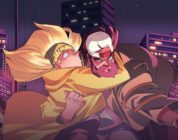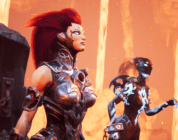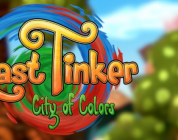Fans of Marvel and its many properties are aware of the company’s exponential growth. Marvel’s success has skyrocketed since being purchased by Disney in 2009. The brand has found massive success branching away from its comic roots, and exploring other forms of media. The massively successful line of cinematic films, dubbed the MCU, has made Marvel into a household name. Their multitude of franchises have also found success in video game adaptations. This includes Insomniac Games’ Spider-Man and Spider-Man Miles Morales, as well as Crystal Dynamics’ Avengers. This year Marvel’s Guardians of The Galaxy received an all-new video game adaptation. While the franchise did see an iteration in 2017’s Telltale series, Eidos-Montréal’s incarnation introduces a new, but familiar, take on the galaxy’s mightiest heroes.
An 80s Invasion
Peter Quill, better known as Star-Lord, is our story’s main protagonist. Raised human by his mother Meredith in the 1980s, it is revealed to Peter on his 13th Birthday, that he is half-alien. That same day, his home is attacked by Chitauri warriors. Meredith is mercilessly killed in front of her son, following the abduction of Peter himself. Forced to grow up with space pirates, he eventually breaks free to enlist in the Galactic War. After serving his galaxy, Peter, now going by the alias Star-Lord, rallies up a group of flawed mercenaries, to lead them into a career of heroes for hire.
The Galaxy’s Mightiest
Marvel’s Guardians of The Galaxy is composed of the ragtag team fans of the franchise know and love. Gamora, the deadliest woman in the galaxy, Drax, The Destroyer, Rocket the genetically modified experimentation, and Groot the last living Flora Colossus. While the characters are based on previous iterations, the game should be considered an alternate universe. The heroes of this timeline are entities of their own. While these alternative versions can take time to get used to, the attachment for them grows as the story progresses. Players will discover more about each members’ past, through key campaign elements and clever usage of flashbacks. Marvel’s Guardians of The Galaxy is a slow burn but tells an incredibly robust story, and really fleshes out each of the 6 Guardians.
Familiar As Flark
Taking place 12 years after the Galactic War, Marvel’s Guardians of The Galaxy occurs later on in our heroes’ comradery. These characters have a history together, which is made apparent by the team’s constant bickering. The voice acting is top-notch, and really gives each of the Guardians personality. This is great because our heroes will be exchanging dialog consistently throughout. As the group’s trusty leader, Star-Lord must often act as the peace-keeper. Often Star-Lord will be forced to make decisions, which impact specific narrative sections. While some choices, early game, will determine the outcome further down the road, these are nothing monumental. They do however promote replayability, as hardcore fans will want to go back and see the alternate paths.
Single-Player Action
Marvel’s Guardians of The Galaxy is a fairly straightforward single-player adventure game. While some gameplay mechanics do take influence from more open-ended genres, this title is a linear action-adventure. The majority of the game sees players exploring environmentally dynamic locations. These sections contain heavy, but entertaining, dialog sections, coupled with platforming and light puzzle-solving. Players control Star-Lord directly, while also leading orders to fellow teammates.
Environmental Challenges
Each of the Guardians of The Galaxy has environmental abilities, which are required to traverse specific sections. For example, Groot can be used to levitate specific panels, which grant Star-Lord access to higher terrain. Drax’s super strength can be used to clear passageways. Similarly, Gamora’s versatility allows her to clear paths with her sword. Rocket, being the smallest of the crew, can enter cramped spaces and hijack security systems. Star-Lord’s Elemental Blasters will also be required to solve specific puzzles. Early on, the element of ice will be unlocked, which must be used to create stable grounding for travel. Star-Lord is also able to use his visor, which reveals mission objectives and hidden collectibles.
Quite Crafty
One of the most useful collectibles found throughout the rich vistas is crafting components. Many of these are well hidden, making good use of the visor’s alternate view. These components are used to unlock new perks, as well as adjustments to Star-Lord’s visor and Elemental Blasters. Contriving these upgrades can only occur at a crafting bench, and with the assistance of Rocket.
Compelling Combat
The rich storytelling and exploration of Marvel’s Guardians of The Galaxy are divided by combat sections. These sections see our protagonist, Star-Lord, shooting his blasters and engaging in melee combat, all while directing his teammates. Star-Lord’s blasters are straightforward, using R1 to aim, R2 to shoot, and R1 to shoot elemental properties. Combat becomes more complicated, factoring in that Star-Lord needs to direct his comrades. The other Guardian’s abilities are accessed similar to how Star-Lord commands them outside of combat. Each of our heroes starts out with one ability, with 3 additional unlockables. These are obtained either through XP upgrades, or crucial story moments.
Pacing Problems
Unfortunately, Marvel’s Guardians of The Galaxy is plagued with some pacing issues. There are often long gaps between the more cinematic sections and the combat. While the game isn’t lacking combat sections, their appearance is lacking uniformity. At times, players will complete large sections without fighting a single enemy, whereas others may have the Guardians defeating various waves. The combat is woven into the story in a very natural way, but from a gameplay perspective, it is incredibly inconsistent.
Group Huddle
Marvel’s Guardians of The Galaxy features a very unique huddle mechanic. As the team defeats enemies in combat, they will fill up the Huddle Meter, located in the bottom right of the screen. Once filled up, pressing L1 and L2 will call the team to a Huddle Up. Here the Guardians will exchange thoughts on the current fight at hand, and look to Star-Lord for inspiration. Players are given two dialog options to choose from. One which will hype up the team, and another that will result in them reprimanding Star-Lord. Choosing the correct answer will cause all members to gain a boost in damage power. The wrong answer will only power up Star-Lord’s damage. Right or wrong answer, any stunned teammate will be revived. Star-Lord will also play a song from his cassette deck, which will play throughout the remainder of the battle.
An 80s Jukebox
The soundtrack features a robust collection of 80s hits. Including heavy-hitters like AHa’s Take On Me, or Bobby McFerrin’s Don’t Worry Be Happy, was incredibly fitting to the world of Guardians of The Galaxy. Throughout all the mediums of the franchise, Peter Quill is known for his love of music. A truly laugh-out-loud moment occurred when he fails to motivate his team, and Rick Astley’s Never Gonna Give You Up played throughout the battle. Fans of the series would agree that music is integral to the Guardians of The Galaxy IP, as it truly sets the mood. For those planning on streaming their gameplay, Square included a Streamer Mode, which replaces all licensed music with that from the fictitious band Star-Lord. The made-for-game music is actually very well-produced. That said, it feels like something is missing, without the licensed songs included.
Inconsistent Voice Acting
As strong as the game’s soundtrack is, the voice acting is very hit or miss. While much of the acting is incredibly well done, a few characters’ voices sound incredibly similar. There were times where the dialog between Star-Lord and Rocket were difficult to differentiate who was who, without having subtitles enabled. This issue isn’t overly consistent but does reoccur later in the game, with some of the newly introduced NPCs. Besides character voices blending at times, most of the Guardians sound great. Groot and Drax’s voices are perfectly matched to their characters. While subjective, Gamora’s voice really didn’t really mesh with her character.
Striking Vistas
The landscapes in Marvel’s Guardians of The Galaxy are visually stunning. With the help of the PlayStation 5’s Ray Tracing capabilities, colors are incredibly vibrant. The game’s atmospheric worlds are very strange, and I mean that in the best way possible. Eidos-Montréal’s development team really dug deep into the franchise’s lore and came up with some incredibly unique locations, which draw inspiration from the comic books. The attention to detail is evident! Besides environmental pop-in during some of the exploration sections, Marvel’s Guardians of The Galaxy is very pleasing on the eyes. Character models are hit or miss, as the development team took creative liberties. While Rocket, Groot, and Drax look as they should, Gamora and Star-Lord do not. It is definitely something that takes getting used to.
Closing Thoughts
Marvel’s Guardians of The Galaxy was sort of just announced, without much information, and released 4 months later. This tactic is typically a sign of a bad game, but Eidos-Montréal did not disappoint!! Going in, my expectations were incredibly low, but as I played through the story the game grew on me more and more. Call it a slow-burner if you will, but those who give it a fair shot will not be disappointed. From start to finish, Marvel’s Guardians of The Galaxy was a pleasurable experience. Eidos-Montréal’s video game adaptation of the galaxy’s mightiest heroes is an excellent homage to the series’ legacy!
Marvel’s Guardians of The Galaxy is available now on PS5, PS4, Xbox, Nintendo Switch, and PC. A digital copy of the game was provided for the purpose of review.










